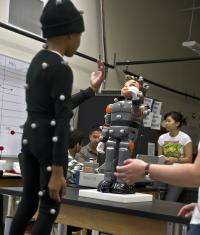Quicker diagnosis, better treatment hoped for autistic children through robot technology

(Medical Xpress) -- Zeno doesn’t make judgments. He has empathetic eyes in a beautiful hazel hue. His lifelike skin is called Frubber and allows his face to smile, frown and look inquisitive.
Zeno is a two-foot tall robot that has facial expressions, can walk and can gesture with two hands.
But most importantly, researchers believe Zeno may be able to help diagnose autism in infants and toddlers – before traditional diagnoses that rely on speech and social interactions may be obvious.
UT Arlington researchers have teamed with colleagues at the University of North Texas Health Science Center, the Dallas Autism Treatment Center, Texas Instruments and Hanson Robotics of Plano to rewire and rework Zeno and other lifelike robots to improve early detection of autism.
Their goal is to create a human robot interaction system that will be used for early diagnosis and treatment for children suffering from autism spectrum disorders. The work is funded in part by a $100,000 grant from the Texas Medical Research Collaborative. Researchers aim to develop a robot that not only interacts with autistic children but that also can measure the child’s movement and indicate what therapies work best.
“We believe the research will lead to a better life for the child with autism,” said Dan Popa, a UT Arlington associate professor of electrical engineering who is the principal investigator for the project. “It’s more than just seeing how autistic children react when interacting with the robot. Eventually, we want to customize the robot to better fit individual needs of children with autism.”
Dan Popa, UT Arlington electrical engineering associate professor.
Carolyn Garver, director of the Dallas Autism Treatment Center, said identifying autism earlier is best for the child because treatment can start earlier.
“Children with autism are intrigued by the robot. Robots are non-judgmental. Sometimes autistic children just shut down with human interaction,” said Garver, who added that one in every 88 children will have an autism spectrum disorder.
TxMRC was founded in 2009 as a collaborative research partnership among The University of Texas at Arlington, The University of Texas at Dallas, Texas Instruments, Texas Health Research & Education Institute, the research and medical education arm of Texas Health Resources, and the University of North Texas Health Science Center. TMAC, or the Texas Manufacturing Assistance Center at UT Arlington, administers the awards.
The annual grants are intended to jumpstart research that can solve real-world problems and develop new technologies in a relatively short time frame. Grant recipients work with representatives of the consortium's academic, industry and health care partners to develop pilot programs aimed at attracting sustained funding from external sources, such as federal, state or private agencies.
Popa also directs the Next Generation Systems group at the University of Texas at Arlington Research Institute. His research focuses on developing robots that are smaller, less expensive, more intelligent, agile and networked than those currently on the market.
Garver said the best possible outcome of the research would be to identify biomarkers though a child’s movement to aid in diagnoses.
“There really are no biological methods of determining autism,” Garver said. “Right now, we just observe. If we can document that a certain eye gaze or motor movement means some level of autism, this could help in develop ways to treat it early on.”
Nicoleta Bugnariu, an associate professor at the UNT Health Science Center and a physical therapist/neuroscientist, said she is most interested in issues of motor control.
“How these children keep their balance, reach for an object and move about a room may be extremely important in diagnosing autism,” Bugnariu said. “If we can detect these motor biomarkers and determine the timing of these differences during the developmental process, that would be of great benefit for diagnosis and treatment.”
Diagnosis of autism usually is based on deficiencies in social interaction and speech problems, researchers said. But with infants or toddlers, an emphasis on motion may aid early childhood detection.
“During the first two years of life, language is a small part of a person,” Bugnariu said. “Children move first, then speech comes. We can’t wait until they use speech. We need to determine sooner who has autism.”
Popa has worked with Hanson Robotics since 2005 when company founder David Hanson first visited UT Arlington’s Robotics Institute in Fort Worth.
Popa said Hanson wanted to make the robot more humanlike, take the robot out of the lab and into the home. He said his team got the initial robot from Hanson but then embedded a new, more performance-controlled system into the robot.
“That way, you can adapt the robot behavior to do anything you want,” Popa said.
Popa said Zeno may incorporate responsive cameras in the robot’s eyes, similar to the technology in game systems like the Microsoft’s Xbox Kinect. Robots with vision tools could record a child’s movements and mimic behavior.
He said robot hardware based on Texas Instruments chips and cameras can be used to fashion the future control and perception system for the robot to record movement from an autistic child.


















